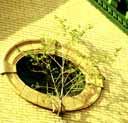 |
|
...Through the outside of your house!
|
 Moisture invasion from the outside "in."
Moisture invasion from the outside "in."Historic houses are notoriously "drafty." They can easily allow rain and damp air to enter through missing mortar in brick or stone and through cracks around windows and doors. In the winter, snow and ice can be particuarly damaging. Ice dams that form in roof gutters can lift up roofing tiles, allowing the ice to melt into attics and exterior walls. Often, deterioration caused by the weather will be evident on the interior before you ever see it on the exterior.
For example, whenever plaster is damaged around windows and you see damp wallpaper, the windows and roofing area above should be inspected. If you haven't found the source of moisture, don't repair!
Ongoing maintenance of the exterior is critical to deter the invaders. Repair deteriorated siding and damaged roofing materials, such as slate, tile, or wood shingles. Overall, keeping up with smaller projects is far preferable to replacing whole areas of historic material with new material. Not only will this be less expensive, your house will retain its authenticity for future generations to enjoy.
On another topic, if you let vines grow directly on brick or wood, they may look mellow, but, without a trellis to hold them away from the house, the roots erode mortar joints and foundations as they seek nourishing dampness within. Vines also hold moisture against exterior surfaces. Though almost everyone enjoys a bit of planned nature in the yard, when nature grows with abandon out of brick walls or cracks in the sidewalks, or on the roof, we should turn on it as the enemy!
Next,
always keep gutters and downspouts in good repair. This is
critical in order to convey moisture away from the house. Dry residue,
such as pine needles from trees, can clog them, making rain water
overflow onto the very historic materials you call "home."
Roofs, gutters & downspouts:
Don't apply "tar goop" (asphaltic compounds) to try to make repairs
because it doesn't work in the long run and can actually damage historic
materials! Keep your roof weather-tight and functioning properly.
Repair the flashing and cracked or broken downspouts. Inspect the
roofing itself at least once a year, preferably in the spring.
Walls: Don't ever apply a waterproof coating to an above-ground masonry wall--it can trap moisture underneath, causing further damage to the historic material. Repair damaged surface materials with care. Repoint masonry with appropriately formulated mortar. Prime and repaint wooden, metal, or masonry elements or surfaces. Foliage: Keep all foliage and vines away from the house. Trim overhanging trees to keep the debris out of gutters and to prevent limbs from rubbing against building materials. Remove moisture-retaining elements, such as shrubbery, from foundations.
|






